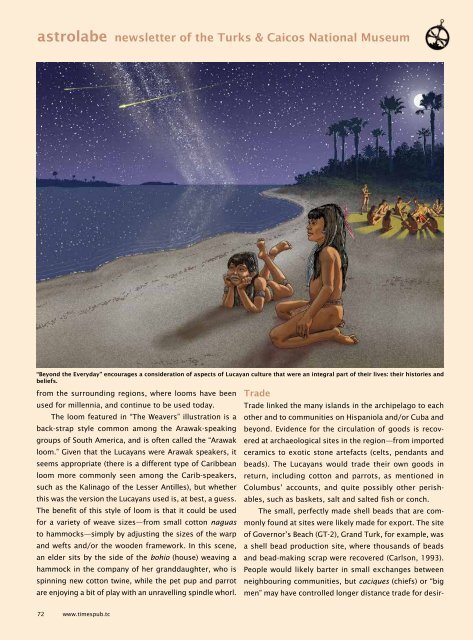Times of the Islands Fall 2020
Presents the "soul of the Turks & Caicos Islands" with in-depth features about local people, culture, history, environment, businesses, resorts, restaurants and activities.
Presents the "soul of the Turks & Caicos Islands" with in-depth features about local people, culture, history, environment, businesses, resorts, restaurants and activities.
You also want an ePaper? Increase the reach of your titles
YUMPU automatically turns print PDFs into web optimized ePapers that Google loves.
astrolabe newsletter <strong>of</strong> <strong>the</strong> Turks & Caicos National Museum<br />
“Beyond <strong>the</strong> Everyday” encourages a consideration <strong>of</strong> aspects <strong>of</strong> Lucayan culture that were an integral part <strong>of</strong> <strong>the</strong>ir lives: <strong>the</strong>ir histories and<br />
beliefs.<br />
from <strong>the</strong> surrounding regions, where looms have been<br />
used for millennia, and continue to be used today.<br />
The loom featured in “The Weavers” illustration is a<br />
back-strap style common among <strong>the</strong> Arawak-speaking<br />
groups <strong>of</strong> South America, and is <strong>of</strong>ten called <strong>the</strong> “Arawak<br />
loom.” Given that <strong>the</strong> Lucayans were Arawak speakers, it<br />
seems appropriate (<strong>the</strong>re is a different type <strong>of</strong> Caribbean<br />
loom more commonly seen among <strong>the</strong> Carib-speakers,<br />
such as <strong>the</strong> Kalinago <strong>of</strong> <strong>the</strong> Lesser Antilles), but whe<strong>the</strong>r<br />
this was <strong>the</strong> version <strong>the</strong> Lucayans used is, at best, a guess.<br />
The benefit <strong>of</strong> this style <strong>of</strong> loom is that it could be used<br />
for a variety <strong>of</strong> weave sizes—from small cotton naguas<br />
to hammocks—simply by adjusting <strong>the</strong> sizes <strong>of</strong> <strong>the</strong> warp<br />
and wefts and/or <strong>the</strong> wooden framework. In this scene,<br />
an elder sits by <strong>the</strong> side <strong>of</strong> <strong>the</strong> bohio (house) weaving a<br />
hammock in <strong>the</strong> company <strong>of</strong> her granddaughter, who is<br />
spinning new cotton twine, while <strong>the</strong> pet pup and parrot<br />
are enjoying a bit <strong>of</strong> play with an unravelling spindle whorl.<br />
Trade<br />
Trade linked <strong>the</strong> many islands in <strong>the</strong> archipelago to each<br />
o<strong>the</strong>r and to communities on Hispaniola and/or Cuba and<br />
beyond. Evidence for <strong>the</strong> circulation <strong>of</strong> goods is recovered<br />
at archaeological sites in <strong>the</strong> region—from imported<br />
ceramics to exotic stone artefacts (celts, pendants and<br />
beads). The Lucayans would trade <strong>the</strong>ir own goods in<br />
return, including cotton and parrots, as mentioned in<br />
Columbus’ accounts, and quite possibly o<strong>the</strong>r perishables,<br />
such as baskets, salt and salted fish or conch.<br />
The small, perfectly made shell beads that are commonly<br />
found at sites were likely made for export. The site<br />
<strong>of</strong> Governor’s Beach (GT-2), Grand Turk, for example, was<br />
a shell bead production site, where thousands <strong>of</strong> beads<br />
and bead-making scrap were recovered (Carlson, 1993).<br />
People would likely barter in small exchanges between<br />
neighbouring communities, but caciques (chiefs) or “big<br />
men” may have controlled longer distance trade for desir-<br />
72 www.timespub.tc

















